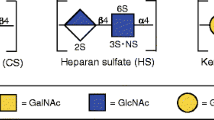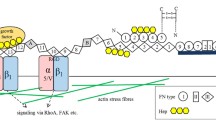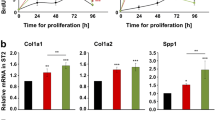Abstract
In anchorage-dependent (AD) cultures of the outer cell population (OCP) from neonatal rat calvaria, transforming growth factor-β1 (TGF-β) specifically upregulated the synthesis of chondroitin sulfate (CS) proteoglycan (PG) and uncoupled the inhibitory effect of increasing cell density on CS PG synthesis (reference #30). Utilizing the same cell population, we have further examined the possibility that glycosaminoglycans (GAG) known to be synthesized and secreted by bone cells might exert feedback effects on GAG synthesis and/or its stimulation by TGF-β. Although addition of TGF-β alone stimulated net synthesis of HA and CS in both AD and anchorage-independent (AI) cultures, significant alterations of basal and TGF-β-stimulated GAG synthesis by exogenous GAGs were observed only in AI cultures. In AI cultures exogenously added hyaluronic acid (HA) markedly enhanced the basal synthesis of HA and CS while heparin (H) suppressed the basal synthesis of HA, CS as well as dermatan sulfate (DS). Also, the addition of HA markedly potentiated the stimulation by TGF-β of HA and CS synthesis as did heparan sulfate (HS) for CS and DS synthesis. H suppressed the stimulation of the synthesis of HA, CS and DS by TGF-β. Overall, our results indicate specific effects of individual GAGs on basal and TGF-β-stimulated GAG synthesis in OCP cultures. We suggest that some of the GAGs in the OCP microenvironment (which with the exception of HA are covalently linked to protein cores of secreted PGs), acting in concert with TGF-β, may serve as an amplification system for upregulating GAG synthesis in the rapidly growing neonatal calvarium.
Similar content being viewed by others
References
Meyer K, Davidson E, Linker A, Hoffman P: The acid mucopolysaccharides of connective tissue. Biochim Biophys Acta 21: 506–518, 1956
Fisher LW, Termine JD, Dejter Jr. SW, Whitson SW, Yanagishita M, Kimura JH, Hascall VC, Kleinman HK, Hassell JR, Nilsson B: Proteoglycans of developing bone. J Biol Chem 258: 6588–6594, 1983
Diamond AG, Triffitt JT, Herring GM: The acidic macromolecules in rabbit cortical bone tissue Arch Oral Biol 27: 337–345, 1982
Hunter GK, Heersche JNM, Aubin JE: Isolation of three species of proteoglycan synthesized by cloned bone cells. Biochemistry 22: 831–837, 1983
Chopra RK, Anastassiades TP, Stephens C, Lohnes D, Jones G: Newly synthesized glycoconjugates from two cell lines derived from rat osteogenic sarcoma: Effects of ‘Matrigenin’ activity from bone. Biochem Cell Biol 69: 49–57, 1991
Chopra RK, Li Z-M, Vickery S, Anastassiades TP: Newly synthesized proteoglycans secreted by sequentially derived populations of cells from new-born rat calvaria: Effects of transforming growth factor-β and matrigenin activity. Cell Differ Dev 32: 47–59, 1990
Ecarot-Charrier B, Broekhuyse H: Proteoglycans synthesized by cultured mouse osteoblasts. J Biol Chem 262: 5345–5351, 1987
Beresford JN, Fedarko NS, Fisher LW, Midura RJ, Yanagishita M, Termine JD, Robey PG: Analysis of proteoglycans synthesized by human bone cells in vitro. J Biol Chem 262: 17164–17172, 1987
Jackson RL, Busch SJ, Cardin AD: Glycosaminoglycans: Molecular properties, protein interactions, and role in physiological processes. Physiol Rev 71: 481–539, 1991
Templeton DM: Proteoglycans in cell regulation. Crit Rev Clin Lab Sci 29:141–184, 1992
Lucas PA, Dziewiatkowski DD: Feedback control of selected biosynthetic activities of chondrocytes in culture. Conn Tiss Res 16: 323–341, 1987
Shimazu A, Jikko A, Iwamoto M, Koike T, Yan W, Okada Y, Shinmei M, Nakamura S, Kato Y: Effects of hyaluronic acid on the release of proteoglycan from the cell matrix in rabbit chondrocyte cultures in the presence and absence of cytokines. Arthritis Rheum 36: 247–253, 1493
Evangelisti R, Stabellini G, Becchetti E, Carinci, P: Exogenous glycosaminoglycans modulate extracellular and intracellular accumulation of newly synthesized glycosaminoglycans by embryonic chick skin fibroblasts. Cell Biol Inter Reps 13: 437–446, 1989
Siczkowski M, Andrew T, Amos S, Gordon MY: Hyaluronic acid regulates the function and distribution of sulfated glycosaminoglycans in bone marrow stromal cultures. Exp Hematol 21: 126–130, 1993
Burgess WH, Maciag T: The heparin-binding (fibroblast) growth factor family of proteins. Annu Rev Biochem 58: 575–606, 1989
Thornton SC, Mueller SN, Levine EM: Human endothelial cells: Use of heparin in cloning and long-term serial cultivation. Science 222: 623–625, 1983
Lobb RR: Thrombin inactivates acidic fibroblast growth factor but not basic fibroblast growth factor. Biochemistry 27: 2572–2578, 1988
Damon DH, Lobb RR, D'Amore PA, Wagner JA: Heparin potentiates the action of acidic fibroblast growth factor by prolonging its biological half-life. J Cell Physiol 138: 221–226, 1989
Yayon A, Klagsbrun M, Esko JD, Leder P, Ornitz DM: Cell surface, heparin-like molecules are required for binding of basic fibroblast growth factor to its high affinity receptor. Cell 64: 841–848, 1991
Robey PG, Young MF, Flanders KC, Roche NS, Kondaiah P, Reddi AH, Termine JD, Sporn MB, Roberts AB: Osteoblasts synthesize and respond to transforming growth factor-type β (TGFβ) in vitro. J Cell Biol 105: 457–463, 1987
Guenther HL, Cecchini MG, Elford PR, Fleisch H: Effects of transforming growth factor type beta upon bone cell populations grown either in monolayer or semisolid medium. J Bone Miner Res 3: 269–278, 1988
Centrella M, Massagué J. Human platelet-derived transforming growth factor-β stimulates parameters of bone growth in fetal rat calvariae. Endocrinology 119: 2306–2312, 1986
Centrella M, McCarthy TL, Canalis E: Transforming growth factor-β is a bifunctional regulator of replication and collagen synthesis in osteoblast-enriched cell cultures from fetal rat bone. J Biol Chem 262: 2869–2874, 1987
Wrana JL, Maeno M, Hawrylyshyn B, Yao K-L, Domenicucci C, Sodek J: Differential effects of transforming growth factor-β on the synthesis of extracellular matrix proteins by normal fetal calvarial bone cell populations. J cell Biol 106: 915–924, 1988
Centrella M, Horowitz MC, Wozney JM, McCarthy TL: Transforming growth factor-β gene family members and bone. Endocr Rev 15: 27–39, 1994
Bassols A, Massague J: Transforming growth factor-β regulates the expression and structure of extracellular matrix chondroitin/dermatan sulfate proteoglycans. J Biol Chem 263: 3039–3045, 1988
Yamaguchi Y, Mann DM, Ruoslahti E: Negative regulation of transforming growth factor-β by the proteoglycan decorin. Nature 346: 281–384, 1990
Cheifetz S, Massagué J: Transforming growth factor-beta (TGF-beta) receptor proteoglycan. Cell surface expression and ligand binding in the absence of glycosaminoglycan chains. J. Biol Chem 264: 12025–12028, 1989
McCaffrey TA, Falcone DJ, Brayton CF, Agarwal LA, Welt FGP, Weksler BB: Transforming growth factor-β activity is potentiated by heparin via dissociation of the transforming growth factor-β/α2 macroglobulin inactive complex. J Cell Biol 109: 441–448, 1989
Anastassiades TP, Chan C: Stimulatory effect of TGF-β on anionic glycoconjugate synthesis by rat calvarial cells: Specificity, uncoupling of cell-density dependence, and modulation by chondroitin sulfate. J Bone Miner Res 8: 1301–1308, 1993
Partridge NC, Alcorn D, Michelangeli VP, Kemp BE, Ryan GB, Martin TJ: Functional properties of hormonally responsive cultured normal and malignant rat osteoblastic cells. Endocrinology 108: 213–219, 1981
Benya PD, Shaffer JD: Dedffferentiated chondrocytes reexpress the differentiated collagen phenotype when cultured in agarose gels. Cell 30: 215–224, 1982
Hronowski L, Anastassiades TP: Rates of glycosaminoglycan synthesis and rates of incorporation of radioactive precursors into newlysynthesized glycosaminoglycans by confluent rat muscle rat fibroblasts. J Biol Chem 255: 9210–9217, 1980
Hronowski L, Anastassiades TP: Detection and quantitation of proteoglycans extracted from cell culture medium and cultured cartilage slices. Anal Biochem 174: 501–511, 1988
Hronowski L, Anastassiades TP: Quantitation and interaction of glycosaminoglycans with Alcian Blue in dimethyl sulfoxide solutions. Anal Biochem 93: 60–72, 1979
Hronowski L, Anastassiades TP: Characterization of glycosaminoglycans-Alcian Blue complexes by elution from cellulose acetate utilizing different MgCI2 concentrations. Anal Biochem 107: 393–405, 1980
Chopra R, Griffith E, Irwin D, Anastassiades TP: Human Tlymphocytes synthesize and secrete a protease resistant proteoglycan in a delayed, serum-dependent response to concanavalin A. Cell Biol Int 15, 25–35, 1991
Skantze KA, Brinckerhoff CE, Collier JP: Use of agarose culture to measure the effect of transforming growth factor β and epidermal growth factor on rabbit articular chondrocytes. Cancer Res 45: 4416–4421, 1985
Imamura T, Mitsui Y: Heparan sulfate and heparin as a potentiator or suppressor of the growth of normal and transformed vascular endothelial cells. Exp Cell Res 172: 92–100, 1987
Massagué J, Cheifetz S, Boyd FT, Andres JL: TGF-β receptors and TGF-β binding proteoglycans: Recent progress in identifying their functional properties. Ann NY Acad Sci 593: 59–72, 1990
Toole BP: Hyaluronan and its binding proteins, the hyaladherins. Curr Opinion Cell Biol 2: 839–844, 1990
Toole BP: Proteoglycans and hyaluronan in morphogenesis and differentiation. In: E.D. Hay (ed.). Cell biology of extracellular matrix, Plenum Press, N.Y., 1991, pp 305–341
Ginsberg JS, Kowalchuck G, Hirsh J, Brill-Edwards P, Burrows R, Coates G, Webber C: Heparin effect on bone density. Thromb Haemostas 64: 286–289, 1990
Author information
Authors and Affiliations
Rights and permissions
About this article
Cite this article
Anastassiades, T.P., Chopra, R.K. & Wood, A. Exogenous glycosaminoglycans (GAG) differentially modulate GAG synthesis by anchorage-independent cultures of the outer cells from neonatal rat calvaria in the absence and presence of TGF-β. Mol Cell Biochem 158, 25–32 (1996). https://doi.org/10.1007/BF00225879
Received:
Accepted:
Published:
Issue Date:
DOI: https://doi.org/10.1007/BF00225879




